Recruiting Recap: Did MSU meet its needs on offense?
Paul Konyndyk • SpartanMag.com
EAST LANSING – Adding an elite wide receiver before the end of the 2018 recruiting cycle would put an exclamation point on Michigan State's offensive recruiting class.
But failure to do so would not overshadow the effectiveness with which Michigan State has addressed existing program needs on offense with nine already-signed prospects from the a 20-man consensus Top 25 recruiting class.
Running Back
Michigan State upgraded its big-play potential at running back with signatures from in-state duo Elijah Collins (6-0, 194) and La’Darius Jefferson (6-2, 215).
A two-sport standout in basketball and football at UD Jesuit, Collins established himself as a priority tailback recruit for Michigan State, early in the process.
“We looked at him and said that this is a guy we had to have,” Mark Dantonio said. “We passed on some other guys to hold for him. We had some other guys that wanted to commit. I just held firm saying that I think we can get this guy. We were very fortunate to do that.”
Collins is multi-position asset capable of playing DB and wideout, beyond the tailback position where his ceiling is highest.
“I firmly see his future at running back,” Dantonio said. “He'll come here and be a running back. He might play on special teams because of his versatility. I don't see him playing defense. He's going to be a guy that's going to touch the ball for us. Again, when you go back and watch senior film or the highlights, the guy can make plays, run through tackles. Has big-playability. He's tough, smart and durable. We're very, very excited.”
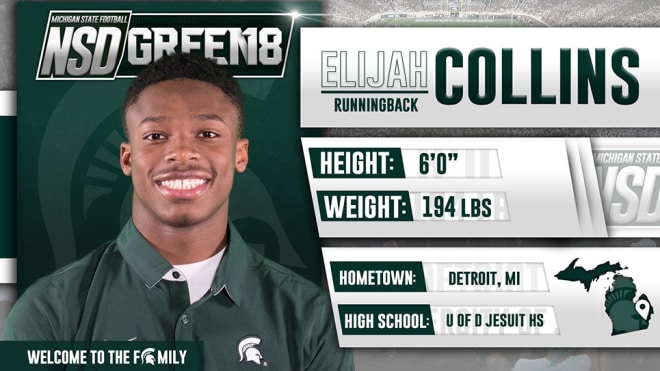
A three-star prospect ranked No. 24 in Michigan by Rivals.com, Collins committed to Michigan State over offers from Iowa, Pittsburgh, Purdue and Wisconsin.
“He has elusiveness, quickness, and change of direction,” co-offensive coordinator Dave Warner said. “When I saw him on I film, before I saw him in person, I just thought he was electric and could be that guy, that could create big plays.”
Ranked No. 18 in Michigan and No. 43 at the catch-all position of athlete, Jefferson first caught the eye of Spartan recruiters on defense, much like Connor Heyward in last year’s class. That was before Jefferson began turning heads in his role piloting Muskegon’s high-powered offense.
“Way back last year when he wasn't playing as much quarterback, played a little bit, we offered him as a linebacker,” Dantonio said. “He has the ability to play linebacker, there's no question about that.”
Jefferson is the latest in a long line of in-state prospects, including Keshawn Martin and Jeremy Langford, to establish themselves as priority recruits with their play on the field as seniors. In his role as a do-everything playmaker at quarterback, Jefferson accounted for 54 touchdowns (33 rushing, 21 passing) and totaled more than 3,200 all-purpose yards.
“I watched so much film on him as the season continued,” Dantonio said. “I really felt like he was too good of an athlete and could play too many positions (not to offer).”
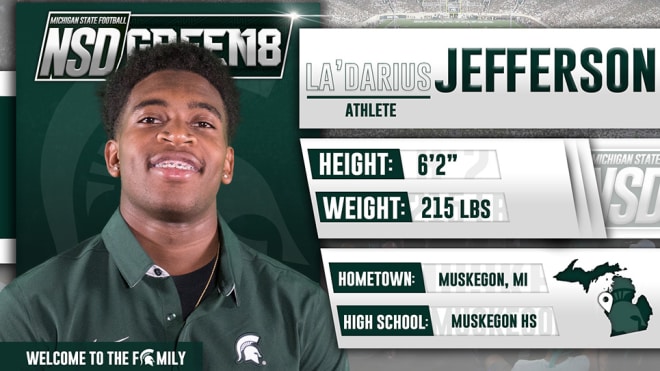
After watching all of that film, Dantonio was struck by similarities between Jefferson and former 2006 Heisman Trophy winner Troy Smith, whom Ohio State signed in 2003.
“We took Troy Smith at the end of recruiting, 17th, 18th, 19th, 20th guy,” Dantonio said. “He could be a tailback, maybe play wide receiver, maybe do this, maybe do that. He ended up being a tremendous quarterback. “That's on him. That's on everybody else. But we're always going to play the best players. I just think he's an extremely good football player. I think he needs to touch the football. When you watch him on offense, he needs to touch the football.”
Warner wasn’t sure how Jefferson would fit at tailback until he watched him play in person as a senior.
“He is a guy that the more you watch, the more you like him,” Warner said. “When I went over and saw him play live, I saw great energy and passion. I saw fire in him, great leadership. Obviously, I saw the athletic ability, him running the football. But the other thing that I saw is that he is an excellent passer.”
BIG PICTURE AT RUNNING BACK: This was a position of critical priority for Michigan State, given the dwindling eligibility of veterans like outgoing senior Gerald Holmes, and juniors LJ Scott and Madre London.
Michigan State should be solid at tailback in 2018 provided Scott and London return as seniors, and Connor Heyward demonstrates the ability to run the ball effectively as sophomore, beyond his current role as sure-handed pass-catcher as true freshman.
Michigan State wants to be better than solid running the football, and raising the bar in the backfield requires physical run blocking by linemen as well as tight ends. As far as running backs go, Michigan State needs more explosive plays.
“We’ve had three great tailbacks for three years, and they’ve all done great things for us,” Warner said. “When you go back to what Jeremy Langford did as far as the home-run hitter, I’m always trying to find that type of guy, that is not only a great North-South runner and strong, but also has the wiggle, explosiveness and the speed to take it the distance.
“Not to say we haven’t had that some, Holmes has had some big runs, as has LJ but Langford was a difference (maker) with his speed.”
Heyward’s emergence as a utility tailback has been much-needed development given the uncertainty with injury-prone freshman Weston Bridges, who was prized as a big-play threat during a productive high school career at Copley (OH) High. Michigan State doesn’t talk about injuries, but I don’t recall seeing Bridges on any home dress list.
With Holmes out, and Scott and London entering the back-stretch of their collegiate careers, Michigan State needs capable personnel at tailback. Heyward is a keeper, but depth at tailback is necessary for consistency running the football, and Collins and Jefferson are fresh bodies with the physical tools required to run the ball effectively.
“I’m not sure that either of these guys have Jeremy Langford speed, but both of them have great elusiveness along with the power. They are a little bit more of that type of back than the LJ, Holmes, Madre, the North-South, strong guys.”
Collins has impressed Spartan recruiters with his ability to catch the ball out of the backfield.
“He played both ways, a threat to catch the ball out of the backfield, but he was also good on defense,” Warner said. “You can see the ball skills, playing the ball in the air on defense, and so forth. He’s an all-around athlete and when you have a guy like that who stays on the field you know he can help you in a lot of different ways.”
Collins has also impressed Warner with his capacity to absorb instruction and put it to use on the field.
“There’s a difference between high school offenses and what we do here,” Warner said. “They need to be able to transition, and he’s good, no doubt.”
Quarterback
Frame, arm strength, and elusiveness are characteristics that should serve
Theo Day
(6-5, 214) well as he grows into the Michigan State program.
The likelihood of Day contending for a starting job at quarterback is impossible to forecast. But signing a quarterback with the physical and mental tools needed for success in major conference program is a priority in each recruiting cycle, and Day has qualities Michigan State seeks at the position.
“I think he's an outstanding leader,” Dantonio said. “Very calm on the practice field when we had him in camp. Dynamic in our camps. When we watched him play in person, just as dynamic. Can throw the ball very effectively. Big arm, big talent. Not afraid to run with it.
“I think really compares favorably with Brian Lewerke in a lot of ways.”
Day is the first in-state quarterback to sign with Michigan State since Joe Boisture in 2010. Aside from both being big-framed quarterbacks, Day and Boisture share little in common.
Boisture, who took a medical disqualification after a year in the Spartan program before resurrecting his football career at Saginaw Valley State, lacked the ability to scramble. Day seems to enjoy the running component of quarterback play.
The No. 13 prospect in Michigan and No. 18 pro-style quarterback in the 2018 class, Day committed to Michigan State as a junior in late February over offers from Boston College, Kentucky, Missouri, and Minnesota among others. He had emerged as a potential high-level recruiting target for the Spartans much earlier in his development.
“Great arm strength,” Dantonio said. “When you look at his highlight film, it's just play after play of him putting the ball down the field. The intermediate throws on target with a lot of velocity on it. The ability to run with the football when needed reminds me a lot of what Lewerke has done this year. Outstanding talent, an opportunity to come early in the process gives him a little bit of an advantage in terms of trying to get on the ground and build a foundation from a quarterback standpoint.”
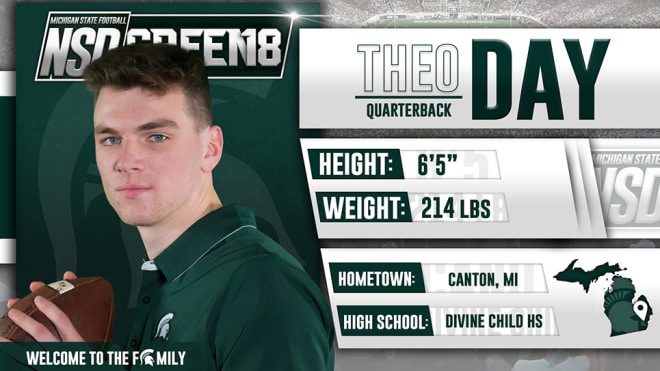
BIG PICTURE AT QB: With
Brian Lewerke
entrenched as Michigan State’s starting quarterback for the next two years, and both
Rocky Lombardi
and
Messiah deWeaver
vying for the role of back-up behind him, it seems likely that Day will cut his teeth as the leader of the scout team offense as a freshman in 2018.
As mid-year enrollees in the class, Day will have an opportunity to begin absorbing Michigan State’s playbook on offense. Where that takes him is anybody’s guess, but having head start could prove beneficial if Michigan State were to experience a rash of injuries, or attrition at quarterback.
Don’t dismiss
La’Darius Jefferson
as an emergency stand-in at quarterback. He was more than glorified tailback as the quarterback for undefeated state champion Muskegon.
“He’s under rated as a quarterback,” Warner said. “They didn’t throw it that much, because they didn’t have to, but I was impressed with his throwing ability.”
Tight End
Numbers-wise, Michigan State could have gotten by without signing a tight end in this class, after reeling in the highly-regarded duo of Matt Dotson and Jack Camper in 2017, and Noah Davis one year earlier.
Then again, Trenton Gillison (6-4, 232) is the type of player you find space for regardless of scholarship limitations. The Pickerington Central star is a gifted receiver with good size, who plays with physicality, and a willingness to mix it up at the point of attack as a blocker.
One of four Top 20 prospects from Ohio to sign with Michigan State in 2018, Gillison checks in at No. 6 player in Ohio, No. 7 at tight end and No. 133 in the Rivals250. He also happens to the best equipped true freshman tight end since Dion Sims in 2009 to be a reliable contributor in year one.
In comparison to Dotson, who broke into the playing rotation at tight end due to his mismatch potential as a receiver, Gillison can give Michigan State a bigger contribution as a blocker in year one.
contribute as a blocker in year one according to Dantonio.
“We didn't lose a tight end, but there's opportunities based on his skill set,” Dantonio said. “He runs very well, catches the ball very well. He's got power. He's used to being at the point of attack. I think a lot of times right now, when you look across the nation, you see tight ends, they're mismatched guys, out of wide receiver, moving in the slot a lot. He's been at the point of attack, traditional tight end alignment. I think he's used to that. He's going to have to play against big people much like himself. I think he does have a skill set to be able to do that.”
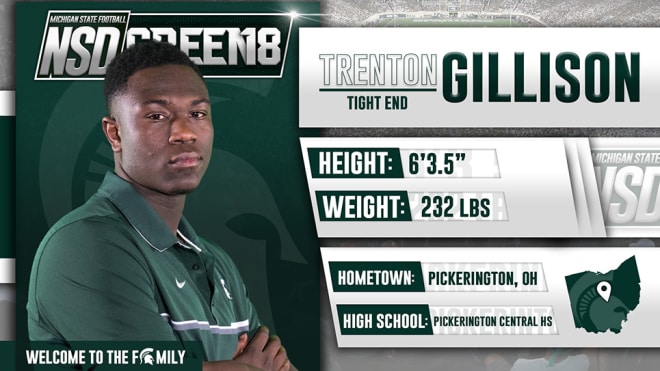
BIG PICTURE AT TIGHT END: Michigan State went through a transition year at tight end in 2017, as Matt Sokol moved to the top of the rotation following two years as an understudy to Josiah Price and Jamal Lyles.
Sokol may never develop the punishing consistency that Paul Lang demonstrated as an impossible-to-replace blocker. But Sokol is improving, and he continues to embrace his inner o-lineman as he strives to develop the all-around consistency of former Spartan tight ends like Charlie Gant or Garrett Celek, when healthy. As a blocker, Sokol has already surpassed the contribution of Lyles and Price as seniors.
And as the leader of the group, Sokol is the tone-setter for youngsters in the tight end room. His willingness to embrace the two-way responsibility of the position, a component critical to success in a pro-style offense - will influence younger players to to do the same.
With Gillison entering the program, Michigan State is building the quality of depth at the tight end the Spartans enjoyed when Kirk Cousins was the program’s starting quarterback.
In 2018, Michigan State may be as deep at tight end as its been at any time during the Dantonio era with Sokol, Davis, and Dotson splitting reps, and both Gillison and Camper pushing for roles.
Offensive Line
After signing a large and talented o-line class in 2017, Michigan State was selective with its offers in 2017, to the extent that some outside observers questioned the wisdom of passing over in-state prospects with impressive early offer lists.
In retrospect, one would be hard-pressed to find fault with Michigan State’s o-line recruiting strategy given the results - a strong three-man class of
Dmitri Douglas
(6-4, 285),
James Ohonba
(6-4, 366) and
Jacob Isaia
(6-3, 272).
As the No. 39 prospect in Georgia, and No. 15 guard in the Class of 2018, Ohonba is massive human with multi-position potential. Coming off a knee injury as a senior, it is unlikely that Ohonba will continue the recent trend of physically gifted youngsters playing as true freshmen.
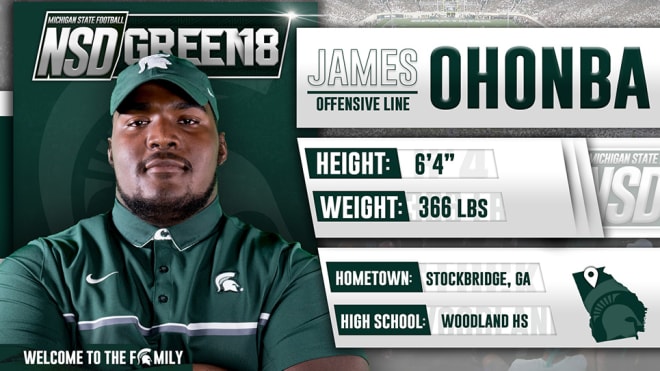
That should in no way diminish his significance to this class.
“Ohomba had everybody on him, and to be honest with you I didn’t think we had a chance at him,” said co-offensive coordinator and Georgia recruiter Dave Warner. “But he decided he wanted to come up and visit, and visited early in the season. He decided that the family atmosphere was for him, and his mom, who is a very intelligent person, an educator, wanted him to get out and experience what goes on outside of Georgia. So that sort of helped. I’m excited about him, he is a big mountain of a guy.”
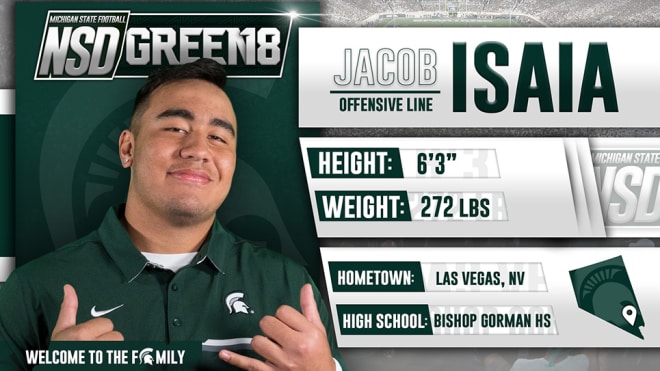
Jacob Isaia - The grandson of Spartan legend Bob Apisa and son of former UCLA star Sale Isaia – emerged as a top o-line priority early in the recruiting process. When Isaia and Ohomba committed to Michigan State within 48 hours in the fall, October, and Ohomba shortly before Spartans early in the recruiting process. His commitment came within days of Ohonba’s decision throw in with the Spartans.
“I think he's a guy that keeps coming,” Dantonio said. “That's really been the statement for this entire program, if you've looked back on the 11 years … He'll be an outstanding player. He's extremely athletic, strong, very strong guy, explosive, very explosive for an offensive lineman. We're looking forward to great things.”
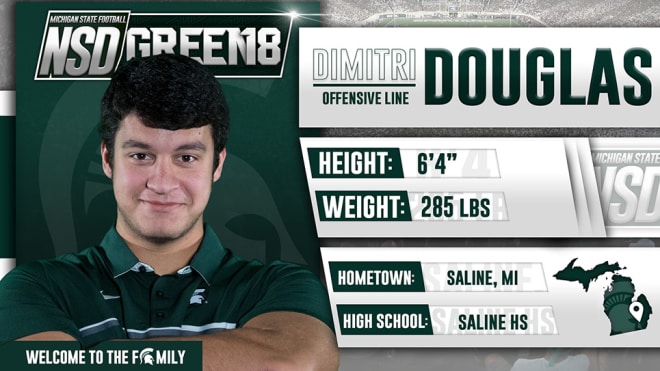
A top in-state recruiting priority, Douglas earned a spot in this class by making a strong impression on Spartan coaches during a one-day camp. At No. 11 in Michigan, Douglass may be ranked slightly lower than a handful of other in-state offensive lineman, who began piling up earlier in the process. But the Spartans wouldn’t trade Douglas for any of the in-state offensive linemen ranked ahead of him, and they are excited about the Saline star’s upside in the Spartan program.
“Really looked the part in our camp,” Dantonio said. “We offered him coming out of camp after an impressive performance. He ran very well. He was a guy we looked at to possibly play any of those positions up front. Outstanding student. Another player that plays for a very good program. 6'4", 285. I think he's going to be an outstanding player for us, as well.”
BIG PICTURE AT O-LINE: Michigan State has quietly overcome attrition and recruiting misfires o-line by signing recent classes featuring quick learners and early contributors. Kevin Jarvis and Jordan Reid were major contributors as true freshmen this season, while Luke Campbell (2016) handled himself nicely as a first-year starter at right tackle, and Matt Allen (2016) gained enough experience as a back-up center and sometimes guard to accelerate his growth and potentially take over the role of starting center.
Beyond those aforementioned players, promising underclassmen like AJ Arcuri (2015), Mustafa Khaleefah (2017), and Matt Carrick (2017), are waiting for an opportunity to prove themselves worthy of a rotation spot. Arcuri and Carrick may have worked their way into contributing roles this season if not for injuries.
Due to the injury he suffered as a senior, Ohonba will not likely push for a playing time as a first-year offensive lineman. And that okay by veteran o-line coach Mark Staten, who’d prefer not to through first year players onto the field before they are ready.
“We’ve played some of these guys as freshman because we’ve had to because of injuries and other reason,” Staten said. “I don’t think its ideal for a freshman, and if you want some perspective on that talk to Brian Allen. He’ll tell you that he wishes he’d been able to redshirt his first year.”
As Michigan State continues to build depth, seeing players like Ohonba, Isaia, and Douglass on the field as true freshman should become less frequent. If each of redshirts this fall, it’s another in a growing list of signs that the Spartans are building toward their past role as Big Ten contender.
Wide Receiver
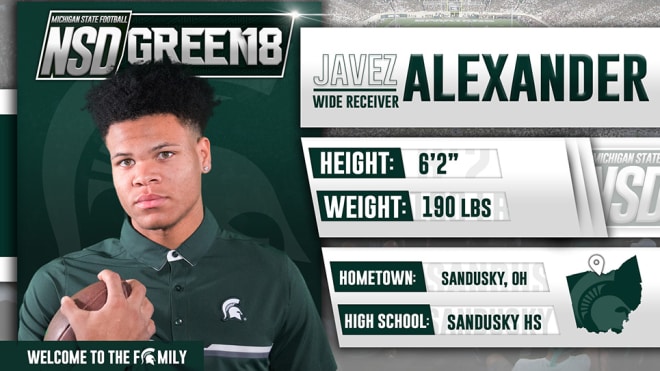
The two-man wide receiver class of
Javez Alexander
(6-2, 190) and
Julian Major
(6-1, 180) does less to move the needle than some of the other two-man classes Michigan State has signed in recent years, including the 2015 class of Felton Davis III and Darrell Stewart, both of whom emerged as critical playmakers for the Spartans this season.
Alexander is an intriguing prospect as a converted quarterback, and third place finisher in Division III offensive player of the year balloting following his senior season at Sandusky.
Michigan State has had a bunch of success with converted quarterbacks at receiver. Tony Lippett, Keshawn Martin, and Darrell Stewart, and Trishton Jackson each played quarterback at in high school before transition to wideout at Michigan State.
One of the biggest things Alexander has going for him are his measurables, including his 10-6 standing broad jump. Every wide receiver prospect with a 10-6 standing broad jump doesn’t make it to the NFL, but one would be hard pressed to find a NFL player at skill position on either offense or defense that doesn’t have a standing broad jump over 10 feet.
“Again, another multifaceted athlete,” Dantonio said. “Big, athletic, explosive. Like Cody White in a lot of ways coming out of high school. I think Cody played much more wide receiver. Javez did not take a snap at wide receiver this year, but in camp looked the part, caught the ball very well. We offered him coming out of camp.”
Alexander accounted for 2,300 yards and 30 touchdowns on offense as an option quarterback.
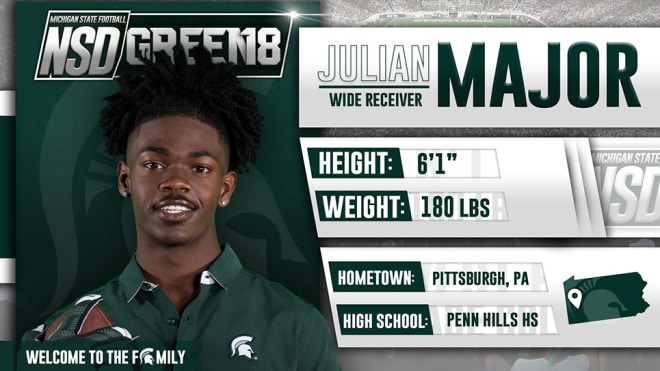
Paul Konyndyk • SpartanMag.com
EAST LANSING – Adding an elite wide receiver before the end of the 2018 recruiting cycle would put an exclamation point on Michigan State's offensive recruiting class.
But failure to do so would not overshadow the effectiveness with which Michigan State has addressed existing program needs on offense with nine already-signed prospects from the a 20-man consensus Top 25 recruiting class.
Running Back
Michigan State upgraded its big-play potential at running back with signatures from in-state duo Elijah Collins (6-0, 194) and La’Darius Jefferson (6-2, 215).
A two-sport standout in basketball and football at UD Jesuit, Collins established himself as a priority tailback recruit for Michigan State, early in the process.
“We looked at him and said that this is a guy we had to have,” Mark Dantonio said. “We passed on some other guys to hold for him. We had some other guys that wanted to commit. I just held firm saying that I think we can get this guy. We were very fortunate to do that.”
Collins is multi-position asset capable of playing DB and wideout, beyond the tailback position where his ceiling is highest.
“I firmly see his future at running back,” Dantonio said. “He'll come here and be a running back. He might play on special teams because of his versatility. I don't see him playing defense. He's going to be a guy that's going to touch the ball for us. Again, when you go back and watch senior film or the highlights, the guy can make plays, run through tackles. Has big-playability. He's tough, smart and durable. We're very, very excited.”

A three-star prospect ranked No. 24 in Michigan by Rivals.com, Collins committed to Michigan State over offers from Iowa, Pittsburgh, Purdue and Wisconsin.
“He has elusiveness, quickness, and change of direction,” co-offensive coordinator Dave Warner said. “When I saw him on I film, before I saw him in person, I just thought he was electric and could be that guy, that could create big plays.”
Ranked No. 18 in Michigan and No. 43 at the catch-all position of athlete, Jefferson first caught the eye of Spartan recruiters on defense, much like Connor Heyward in last year’s class. That was before Jefferson began turning heads in his role piloting Muskegon’s high-powered offense.
“Way back last year when he wasn't playing as much quarterback, played a little bit, we offered him as a linebacker,” Dantonio said. “He has the ability to play linebacker, there's no question about that.”
Jefferson is the latest in a long line of in-state prospects, including Keshawn Martin and Jeremy Langford, to establish themselves as priority recruits with their play on the field as seniors. In his role as a do-everything playmaker at quarterback, Jefferson accounted for 54 touchdowns (33 rushing, 21 passing) and totaled more than 3,200 all-purpose yards.
“I watched so much film on him as the season continued,” Dantonio said. “I really felt like he was too good of an athlete and could play too many positions (not to offer).”

After watching all of that film, Dantonio was struck by similarities between Jefferson and former 2006 Heisman Trophy winner Troy Smith, whom Ohio State signed in 2003.
“We took Troy Smith at the end of recruiting, 17th, 18th, 19th, 20th guy,” Dantonio said. “He could be a tailback, maybe play wide receiver, maybe do this, maybe do that. He ended up being a tremendous quarterback. “That's on him. That's on everybody else. But we're always going to play the best players. I just think he's an extremely good football player. I think he needs to touch the football. When you watch him on offense, he needs to touch the football.”
Warner wasn’t sure how Jefferson would fit at tailback until he watched him play in person as a senior.
“He is a guy that the more you watch, the more you like him,” Warner said. “When I went over and saw him play live, I saw great energy and passion. I saw fire in him, great leadership. Obviously, I saw the athletic ability, him running the football. But the other thing that I saw is that he is an excellent passer.”
BIG PICTURE AT RUNNING BACK: This was a position of critical priority for Michigan State, given the dwindling eligibility of veterans like outgoing senior Gerald Holmes, and juniors LJ Scott and Madre London.
Michigan State should be solid at tailback in 2018 provided Scott and London return as seniors, and Connor Heyward demonstrates the ability to run the ball effectively as sophomore, beyond his current role as sure-handed pass-catcher as true freshman.
Michigan State wants to be better than solid running the football, and raising the bar in the backfield requires physical run blocking by linemen as well as tight ends. As far as running backs go, Michigan State needs more explosive plays.
“We’ve had three great tailbacks for three years, and they’ve all done great things for us,” Warner said. “When you go back to what Jeremy Langford did as far as the home-run hitter, I’m always trying to find that type of guy, that is not only a great North-South runner and strong, but also has the wiggle, explosiveness and the speed to take it the distance.
“Not to say we haven’t had that some, Holmes has had some big runs, as has LJ but Langford was a difference (maker) with his speed.”
Heyward’s emergence as a utility tailback has been much-needed development given the uncertainty with injury-prone freshman Weston Bridges, who was prized as a big-play threat during a productive high school career at Copley (OH) High. Michigan State doesn’t talk about injuries, but I don’t recall seeing Bridges on any home dress list.
With Holmes out, and Scott and London entering the back-stretch of their collegiate careers, Michigan State needs capable personnel at tailback. Heyward is a keeper, but depth at tailback is necessary for consistency running the football, and Collins and Jefferson are fresh bodies with the physical tools required to run the ball effectively.
“I’m not sure that either of these guys have Jeremy Langford speed, but both of them have great elusiveness along with the power. They are a little bit more of that type of back than the LJ, Holmes, Madre, the North-South, strong guys.”
Collins has impressed Spartan recruiters with his ability to catch the ball out of the backfield.
“He played both ways, a threat to catch the ball out of the backfield, but he was also good on defense,” Warner said. “You can see the ball skills, playing the ball in the air on defense, and so forth. He’s an all-around athlete and when you have a guy like that who stays on the field you know he can help you in a lot of different ways.”
Collins has also impressed Warner with his capacity to absorb instruction and put it to use on the field.
“There’s a difference between high school offenses and what we do here,” Warner said. “They need to be able to transition, and he’s good, no doubt.”
Quarterback
Frame, arm strength, and elusiveness are characteristics that should serve
Theo Day
(6-5, 214) well as he grows into the Michigan State program.
The likelihood of Day contending for a starting job at quarterback is impossible to forecast. But signing a quarterback with the physical and mental tools needed for success in major conference program is a priority in each recruiting cycle, and Day has qualities Michigan State seeks at the position.
“I think he's an outstanding leader,” Dantonio said. “Very calm on the practice field when we had him in camp. Dynamic in our camps. When we watched him play in person, just as dynamic. Can throw the ball very effectively. Big arm, big talent. Not afraid to run with it.
“I think really compares favorably with Brian Lewerke in a lot of ways.”
Day is the first in-state quarterback to sign with Michigan State since Joe Boisture in 2010. Aside from both being big-framed quarterbacks, Day and Boisture share little in common.
Boisture, who took a medical disqualification after a year in the Spartan program before resurrecting his football career at Saginaw Valley State, lacked the ability to scramble. Day seems to enjoy the running component of quarterback play.
The No. 13 prospect in Michigan and No. 18 pro-style quarterback in the 2018 class, Day committed to Michigan State as a junior in late February over offers from Boston College, Kentucky, Missouri, and Minnesota among others. He had emerged as a potential high-level recruiting target for the Spartans much earlier in his development.
“Great arm strength,” Dantonio said. “When you look at his highlight film, it's just play after play of him putting the ball down the field. The intermediate throws on target with a lot of velocity on it. The ability to run with the football when needed reminds me a lot of what Lewerke has done this year. Outstanding talent, an opportunity to come early in the process gives him a little bit of an advantage in terms of trying to get on the ground and build a foundation from a quarterback standpoint.”

BIG PICTURE AT QB: With
Brian Lewerke
entrenched as Michigan State’s starting quarterback for the next two years, and both
Rocky Lombardi
and
Messiah deWeaver
vying for the role of back-up behind him, it seems likely that Day will cut his teeth as the leader of the scout team offense as a freshman in 2018.
As mid-year enrollees in the class, Day will have an opportunity to begin absorbing Michigan State’s playbook on offense. Where that takes him is anybody’s guess, but having head start could prove beneficial if Michigan State were to experience a rash of injuries, or attrition at quarterback.
Don’t dismiss
La’Darius Jefferson
as an emergency stand-in at quarterback. He was more than glorified tailback as the quarterback for undefeated state champion Muskegon.
“He’s under rated as a quarterback,” Warner said. “They didn’t throw it that much, because they didn’t have to, but I was impressed with his throwing ability.”
Tight End
Numbers-wise, Michigan State could have gotten by without signing a tight end in this class, after reeling in the highly-regarded duo of Matt Dotson and Jack Camper in 2017, and Noah Davis one year earlier.
Then again, Trenton Gillison (6-4, 232) is the type of player you find space for regardless of scholarship limitations. The Pickerington Central star is a gifted receiver with good size, who plays with physicality, and a willingness to mix it up at the point of attack as a blocker.
One of four Top 20 prospects from Ohio to sign with Michigan State in 2018, Gillison checks in at No. 6 player in Ohio, No. 7 at tight end and No. 133 in the Rivals250. He also happens to the best equipped true freshman tight end since Dion Sims in 2009 to be a reliable contributor in year one.
In comparison to Dotson, who broke into the playing rotation at tight end due to his mismatch potential as a receiver, Gillison can give Michigan State a bigger contribution as a blocker in year one.
contribute as a blocker in year one according to Dantonio.
“We didn't lose a tight end, but there's opportunities based on his skill set,” Dantonio said. “He runs very well, catches the ball very well. He's got power. He's used to being at the point of attack. I think a lot of times right now, when you look across the nation, you see tight ends, they're mismatched guys, out of wide receiver, moving in the slot a lot. He's been at the point of attack, traditional tight end alignment. I think he's used to that. He's going to have to play against big people much like himself. I think he does have a skill set to be able to do that.”

BIG PICTURE AT TIGHT END: Michigan State went through a transition year at tight end in 2017, as Matt Sokol moved to the top of the rotation following two years as an understudy to Josiah Price and Jamal Lyles.
Sokol may never develop the punishing consistency that Paul Lang demonstrated as an impossible-to-replace blocker. But Sokol is improving, and he continues to embrace his inner o-lineman as he strives to develop the all-around consistency of former Spartan tight ends like Charlie Gant or Garrett Celek, when healthy. As a blocker, Sokol has already surpassed the contribution of Lyles and Price as seniors.
And as the leader of the group, Sokol is the tone-setter for youngsters in the tight end room. His willingness to embrace the two-way responsibility of the position, a component critical to success in a pro-style offense - will influence younger players to to do the same.
With Gillison entering the program, Michigan State is building the quality of depth at the tight end the Spartans enjoyed when Kirk Cousins was the program’s starting quarterback.
In 2018, Michigan State may be as deep at tight end as its been at any time during the Dantonio era with Sokol, Davis, and Dotson splitting reps, and both Gillison and Camper pushing for roles.
Offensive Line
After signing a large and talented o-line class in 2017, Michigan State was selective with its offers in 2017, to the extent that some outside observers questioned the wisdom of passing over in-state prospects with impressive early offer lists.
In retrospect, one would be hard-pressed to find fault with Michigan State’s o-line recruiting strategy given the results - a strong three-man class of
Dmitri Douglas
(6-4, 285),
James Ohonba
(6-4, 366) and
Jacob Isaia
(6-3, 272).
As the No. 39 prospect in Georgia, and No. 15 guard in the Class of 2018, Ohonba is massive human with multi-position potential. Coming off a knee injury as a senior, it is unlikely that Ohonba will continue the recent trend of physically gifted youngsters playing as true freshmen.

That should in no way diminish his significance to this class.
“Ohomba had everybody on him, and to be honest with you I didn’t think we had a chance at him,” said co-offensive coordinator and Georgia recruiter Dave Warner. “But he decided he wanted to come up and visit, and visited early in the season. He decided that the family atmosphere was for him, and his mom, who is a very intelligent person, an educator, wanted him to get out and experience what goes on outside of Georgia. So that sort of helped. I’m excited about him, he is a big mountain of a guy.”

Jacob Isaia - The grandson of Spartan legend Bob Apisa and son of former UCLA star Sale Isaia – emerged as a top o-line priority early in the recruiting process. When Isaia and Ohomba committed to Michigan State within 48 hours in the fall, October, and Ohomba shortly before Spartans early in the recruiting process. His commitment came within days of Ohonba’s decision throw in with the Spartans.
“I think he's a guy that keeps coming,” Dantonio said. “That's really been the statement for this entire program, if you've looked back on the 11 years … He'll be an outstanding player. He's extremely athletic, strong, very strong guy, explosive, very explosive for an offensive lineman. We're looking forward to great things.”

A top in-state recruiting priority, Douglas earned a spot in this class by making a strong impression on Spartan coaches during a one-day camp. At No. 11 in Michigan, Douglass may be ranked slightly lower than a handful of other in-state offensive lineman, who began piling up earlier in the process. But the Spartans wouldn’t trade Douglas for any of the in-state offensive linemen ranked ahead of him, and they are excited about the Saline star’s upside in the Spartan program.
“Really looked the part in our camp,” Dantonio said. “We offered him coming out of camp after an impressive performance. He ran very well. He was a guy we looked at to possibly play any of those positions up front. Outstanding student. Another player that plays for a very good program. 6'4", 285. I think he's going to be an outstanding player for us, as well.”
BIG PICTURE AT O-LINE: Michigan State has quietly overcome attrition and recruiting misfires o-line by signing recent classes featuring quick learners and early contributors. Kevin Jarvis and Jordan Reid were major contributors as true freshmen this season, while Luke Campbell (2016) handled himself nicely as a first-year starter at right tackle, and Matt Allen (2016) gained enough experience as a back-up center and sometimes guard to accelerate his growth and potentially take over the role of starting center.
Beyond those aforementioned players, promising underclassmen like AJ Arcuri (2015), Mustafa Khaleefah (2017), and Matt Carrick (2017), are waiting for an opportunity to prove themselves worthy of a rotation spot. Arcuri and Carrick may have worked their way into contributing roles this season if not for injuries.
Due to the injury he suffered as a senior, Ohonba will not likely push for a playing time as a first-year offensive lineman. And that okay by veteran o-line coach Mark Staten, who’d prefer not to through first year players onto the field before they are ready.
“We’ve played some of these guys as freshman because we’ve had to because of injuries and other reason,” Staten said. “I don’t think its ideal for a freshman, and if you want some perspective on that talk to Brian Allen. He’ll tell you that he wishes he’d been able to redshirt his first year.”
As Michigan State continues to build depth, seeing players like Ohonba, Isaia, and Douglass on the field as true freshman should become less frequent. If each of redshirts this fall, it’s another in a growing list of signs that the Spartans are building toward their past role as Big Ten contender.
Wide Receiver

The two-man wide receiver class of
Javez Alexander
(6-2, 190) and
Julian Major
(6-1, 180) does less to move the needle than some of the other two-man classes Michigan State has signed in recent years, including the 2015 class of Felton Davis III and Darrell Stewart, both of whom emerged as critical playmakers for the Spartans this season.
Alexander is an intriguing prospect as a converted quarterback, and third place finisher in Division III offensive player of the year balloting following his senior season at Sandusky.
Michigan State has had a bunch of success with converted quarterbacks at receiver. Tony Lippett, Keshawn Martin, and Darrell Stewart, and Trishton Jackson each played quarterback at in high school before transition to wideout at Michigan State.
One of the biggest things Alexander has going for him are his measurables, including his 10-6 standing broad jump. Every wide receiver prospect with a 10-6 standing broad jump doesn’t make it to the NFL, but one would be hard pressed to find a NFL player at skill position on either offense or defense that doesn’t have a standing broad jump over 10 feet.
“Again, another multifaceted athlete,” Dantonio said. “Big, athletic, explosive. Like Cody White in a lot of ways coming out of high school. I think Cody played much more wide receiver. Javez did not take a snap at wide receiver this year, but in camp looked the part, caught the ball very well. We offered him coming out of camp.”
Alexander accounted for 2,300 yards and 30 touchdowns on offense as an option quarterback.
